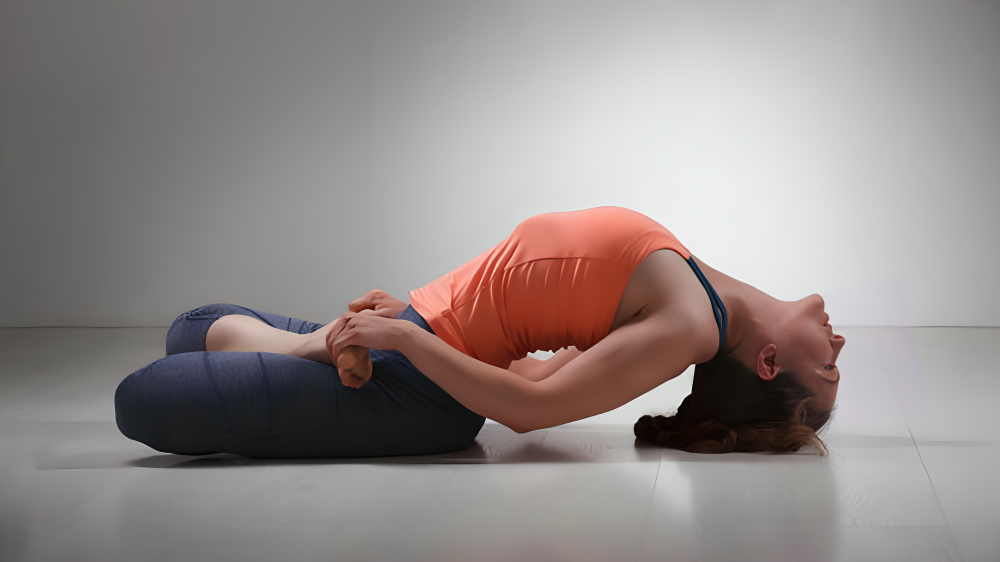
What Is Matsyasana?
Matsyasana, or Fish Pose, often serves as a counterpose for shoulder stands, or any posture that stretches the neck. It opens up one’s heart and is a mild method of stretching the front of the body while strengthening its back muscles. Lying on your back, you lift up your chest and immediately this becomes an invitation for deep breathing, very calming.
How to Do Matsyasana
Lie Down on Your Back:
Lie down on your back upon your yoga mat. Keep your legs straight, with your feet touching each other.
Place Your Hands Under Your Hips:
Slide your hands, with the palms facing down, under your hips. This will provide support to your lower back while you are in this asana.
Lift Your Chest:
Press into your forearms, inhaling as you press your chest up toward the ceiling. Allow your head to release back, keeping the crown of your head lightly touching the mat. Don’t let your head bear too much weight-make sure your forearms are actively engaged.
Arc Your Back:
Allow your back to take an arched shape. Allow your legs to extend and your toes to point away from your body. Make sure your throat is open and your shoulders are relaxed.
Maintain the Pose:
Take deep breaths and maintain Matsyasana for 15 to 30 seconds. With every inhalation, feel your chest expansion and with every exhalation, feel yourself releasing.
Release the Pose:
Press into your elbows to come out of the pose and gently lift your head off the mat. Lower your chest and lie flat on your back again. Relax and take a few deep breaths.
Benefits of Matsyasana
Opens Up the Chest and Lungs
Matsyasana is basically opening up the chest. Lifting up the chest and expanding the rib cage will help improve lung capacity and promote deeper breathing. This is especially helpful for people suffering from respiratory issues or for those intending to improve their breathing patterns.
Stretches the Upper Back and Neck
The forward bend gives a gentle stretch to the muscles at the upper back and neck. It is very helpful for people who always stay seated at their desk or in front of screens because it reverses the effects of slouching and poor posture.
Strengthens the Back and Core Muscles
Matsyasana strengthens the muscles at the back and core because engaging them is quite helpful in maintaining the pose. The muscles of one’s back and core are very important in relation to good posture and the prevention of back pain.
Stimulates the Thyroid and Parathyroid Glands
Matsyasana stimulates the thyroid and parathyroid glands, which are located in the neck. These are extremely important to maintain metabolism and calcium levels in the body. The asana gently stretches the neck to promote healthy functioning of the glands.
Relieves Stress and Fatigue
This Matsyasana may help in releasing body tension and, therefore, mental tension, due to the gentle backbend and opening of the chest. The asana does have a promotive effect on relaxation and can be quite soothing; thus, it is stress- and fatigue-comforting.
Improves Posture
Regular practice of Matsyasana will help heighten your posture by stretching the chest and strengthening the musculature of the back. It can maintain an open and tall posture that counters excessive slouching and rounding of the shoulders.
It’s here Ustrasana How to Do It and what are the Benefits
FAQs
Q: Who can practice Matsyasana?
A: Matsyasana is generally considered a non-weight-bearing pose, thus safe for most people; however, individuals with injuries around the neck and lower back should avoid it or do it only under the guidance of a qualified instructor.
Q: How often can I do Matsyasana?
A: Matsyasana can be done 2-3 times in a week, depending on how comfortable you are and on your general yoga practice. Make sure you don’t overdo it and that you pay attention to your body.
Q: Will Matsyasana help with respiratory problems?
A: Yes, Matsyasana helps increase the capacity of your lungs and promotes deeper breathing, which, in turn, is of some benefit to patients with respiratory problems. However, it must not replace medical treatment.
Q: What if I am not able to lift my chest high enough?
A: If you’re having trouble lifting your chest, try placing a folded blanket or yoga block under your upper back for support. It can help you get into the pose.

